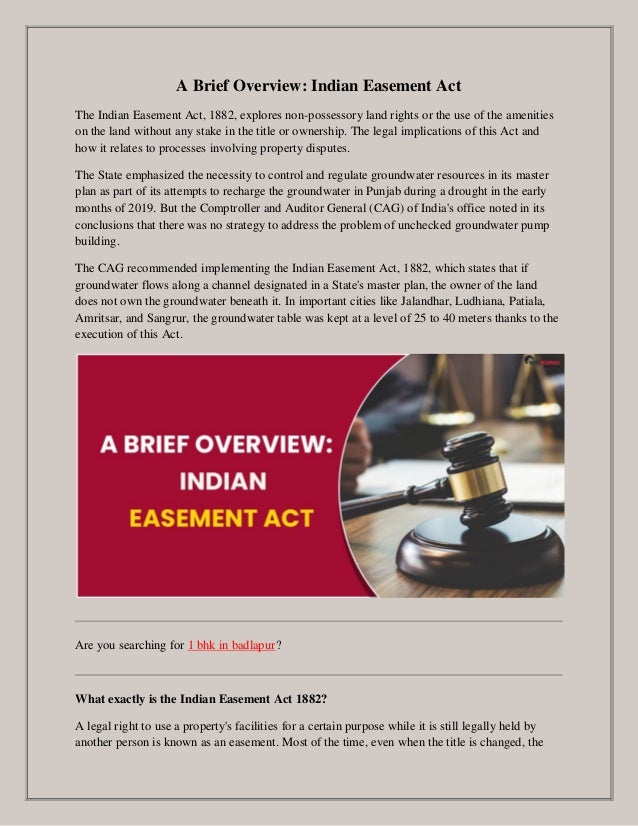
A Brief Overview Indian Easement Act
- 1. A Brief Overview: Indian Easement Act The Indian Easement Act, 1882, explores non-possessory land rights or the use of the amenities on the land without any stake in the title or ownership. The legal implications of this Act and how it relates to processes involving property disputes. The State emphasized the necessity to control and regulate groundwater resources in its master plan as part of its attempts to recharge the groundwater in Punjab during a drought in the early months of 2019. But the Comptroller and Auditor General (CAG) of India's office noted in its conclusions that there was no strategy to address the problem of unchecked groundwater pump building. The CAG recommended implementing the Indian Easement Act, 1882, which states that if groundwater flows along a channel designated in a State's master plan, the owner of the land does not own the groundwater beneath it. In important cities like Jalandhar, Ludhiana, Patiala, Amritsar, and Sangrur, the groundwater table was kept at a level of 25 to 40 meters thanks to the execution of this Act. Are you searching for 1 bhk in badlapur? What exactly is the Indian Easement Act 1882? A legal right to use a property's facilities for a certain purpose while it is still legally held by another person is known as an easement. Most of the time, even when the title is changed, the
- 2. new owners permit the "easement owner" to continue using the property. The Indian Easement Act of 1882 governs easement laws. The definition of "easement" under Section 4 of this Act is the privilege to use someone else's property for a specific purpose. If the beneficiary has been using the land parcel for a considerable amount of time, the right to an easement may be legally transferred to them, either by a grant or by prescription. What Must An Easement Have In Order To Exist? According to Section 4 of the Indian Easement Act, 1882, the idea of an easement over property entails a number of fundamental terms of usage that are legally specified. Which are: Dominating Owner and Dominant Heritage The dominant owner is the landowner who has rights over land that is not his own. The land under this situation is referred to as the dominant legacy or dominating tenement. Heritage of Service and Owner of Service The property is referred to as a servient heritage or servient tenement, and the actual owner is known to as the servient owner. The servient owner cannot protest to the dominant owner using his land. When referring to the dominant owner and the servient owner, various phrases are used to refer to the same parcel of land. As an illustration, suppose A owns some land and gives B an easement over it. In this case, A is the servient owner and comes from a servient family. B has the dominating heritage and is the dominant owner. The dominant and servient owners must be distinct, so the owner of the land cannot obtain an easement over it as he already holds the title. Either A Good or Bad Easement A positive easement, as defined by Section 7 of the Act, occurs when the dominant owner establishes his right to the land through certain actions, such as using the water that runs through it or constructing a walkway for people. A negative easement exists when the dominant owner uses whatever means, whether legal or illegal, to restrict the servient owner's use of the property. Easement Cancellation As in the case mentioned above by the State of Punjab against the landowners, the servient owner may issue the easement straight away. The State government removed the landowners' prior right to utilize the groundwater beneath the property. In this instance, the servient owner was the State by default. Even while the landowners possessed rights over the land they owned under Section 37 of the Act, they only have non-possessory rights, or easement rights, over the amenities that came with the land.
- 3. What Various Easements? According to Section 5 of the Indian Easement Act of 1882, there are four different sorts of easements, based on the type of land involved, the relationships between the parties, and the use for which the easement is being granted. Which are: Easement: Continuous or Non-Continuous In a continuous easement, the use of the property's rights may continue without the need for a "act of man," such as when exploiting the land's water resources or allowing cattle to graze on existing pastures. A non-continuous easement is one that needs human interaction to be used, such as when restroom facilities need to be built. Easement: Visible or Not- Visible A visible easement, also called an express easement, is one in which the easement is plainly stated and readily apparent, such as by way of a signboard or a permanent structure constructed on land. It is known as a non-visible or invisible easement when the easement is not visible. To specify the non-possessory rights over a parcel of property that does not call for the transfer of title, the Indian Easement Act, 1882, is crucial. These include, among others, the obligation to give way to pedestrians, the right to use air or water over land, and the obligation to maintain facilities on the ground. You’re looking for New Projects in Thane West we have the Best New Projects Thane West like Ready to Move & nearby possession: https://navimumbaihouses.com/properties/search/thane-west/ If you want daily property update details please follow us on Facebook Page / YouTube Channel / Twitter